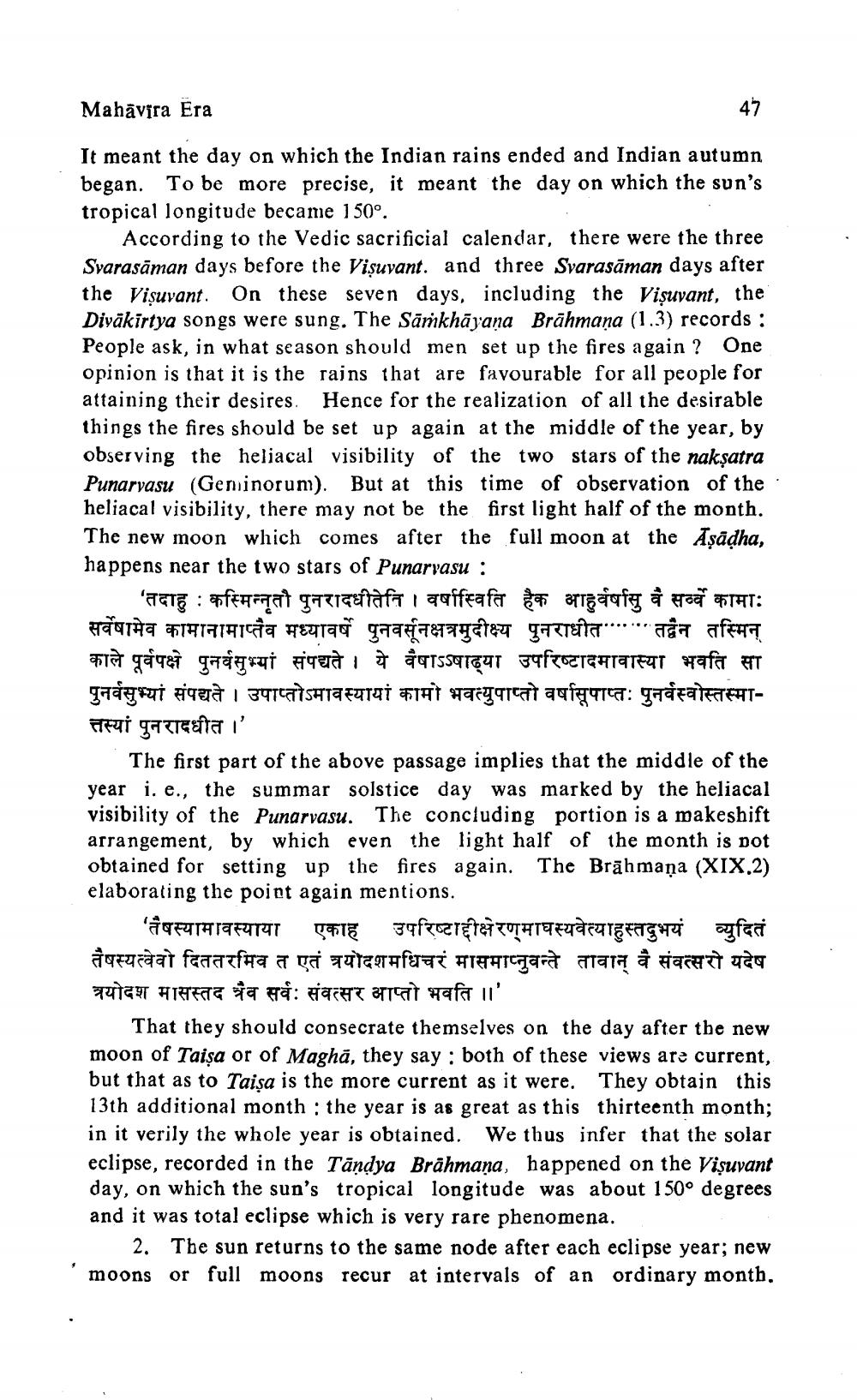________________
47
Mahavira Era
It meant the day on which the Indian rains ended and Indian autumn began. To be more precise, it meant the day on which the sun's tropical longitude became 150°.
According to the Vedic sacrificial calendar, there were the three Svarasāman days before the Vișuvant. and three Svarasāman days after the Visuvant. On these seven days, including the Vișuvant, the Diväkirtya songs were sung. The Samkhāyaṇa Brāhmaṇa (1.3) records : People ask, in what season should men set up the fires again? One opinion is that it is the rains that are favourable for all people for attaining their desires. Hence for the realization of all the desirable things the fires should be set up again at the middle of the year, by observing the heliacal visibility of the two stars of the nakṣatra Punarvasu (Geminorum). But at this time of observation of the heliacal visibility, there may not be the first light half of the month. The new moon which comes after the full moon at the Aṣāḍha, happens near the two stars of Punarvasu:
' तदाहु: कस्मिन्नृतौ पुनरादधीतेति । वर्षास्विति हैक आहुर्वर्षासु वै सर्व्वे कामा: सर्वेषामेव कामानामाप्तैव मध्यावर्षे पुनवसूंनक्षत्रमुदीक्ष्य पुनराधीत तद्वैन तस्मिन् काले पूर्वपक्षे पुनर्वसुभ्यां संपद्यते । ये वैषाऽऽषाढ्या उपरिष्टादमावास्या भवति सा gadgsai aqaà | 391ca7s#1ae91ai %14† #acgqrcat aqfgora: gadzaleaem1तस्यां पुनरादधीत ।'
The first part of the above passage implies that the middle of the year i. e., the summar solstice day was marked by the heliacal visibility of the Punarvasu. The concluding portion is a makeshift arrangement, by which even the light half of the month is not obtained for setting up the fires again. The Brāhmaṇa (XIX,2) elaborating the point again mentions.
'तैषस्यामावस्याया एकाह उपरिष्टाद्दीक्षे रण माघस्यवेत्याहुस्तदुभयं व्युदितं तैस्त्वेव दिततरमिव त एतं त्रयोदशमधिचरं मासमाप्नुवन्ते तावान् वै संवत्सरो यदेष त्रयोदश मासस्तद त्रैव सर्वः संवत्सर आप्तो भवति ।। '
That they should consecrate themselves on the day after the new moon of Taisa or of Magha, they say: both of these views are current, but that as to Taișa is the more current as it were. They obtain this 13th additional month: the year is as great as this thirteenth month; in it verily the whole year is obtained. We thus infer that the solar eclipse, recorded in the Tandya Brāhmaṇa, happened on the Visuvant day, on which the sun's tropical longitude was about 150° degrees and it was total eclipse which is very rare phenomena.
2. The sun returns to the same node after each eclipse year; new or full moons recur at intervals of an ordinary month.
moons




